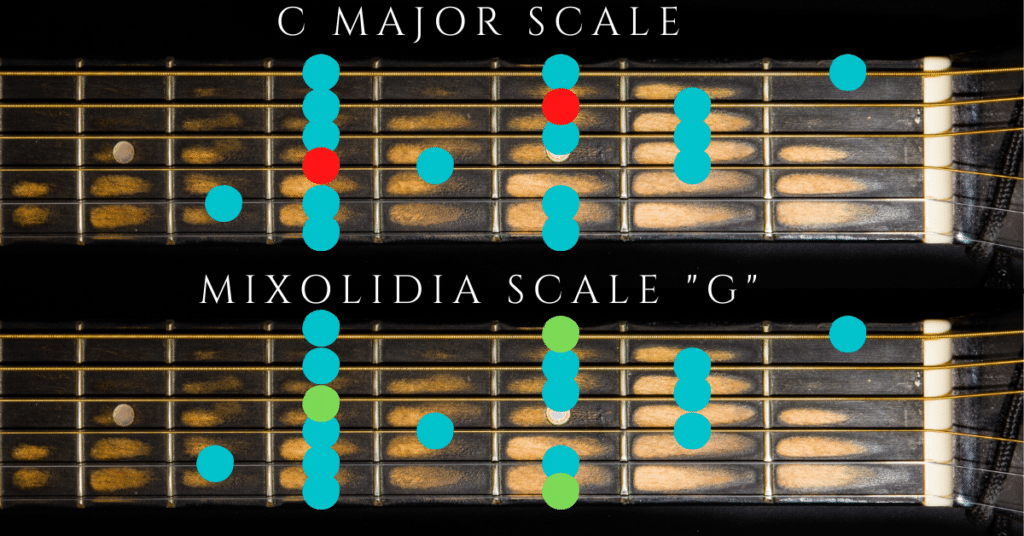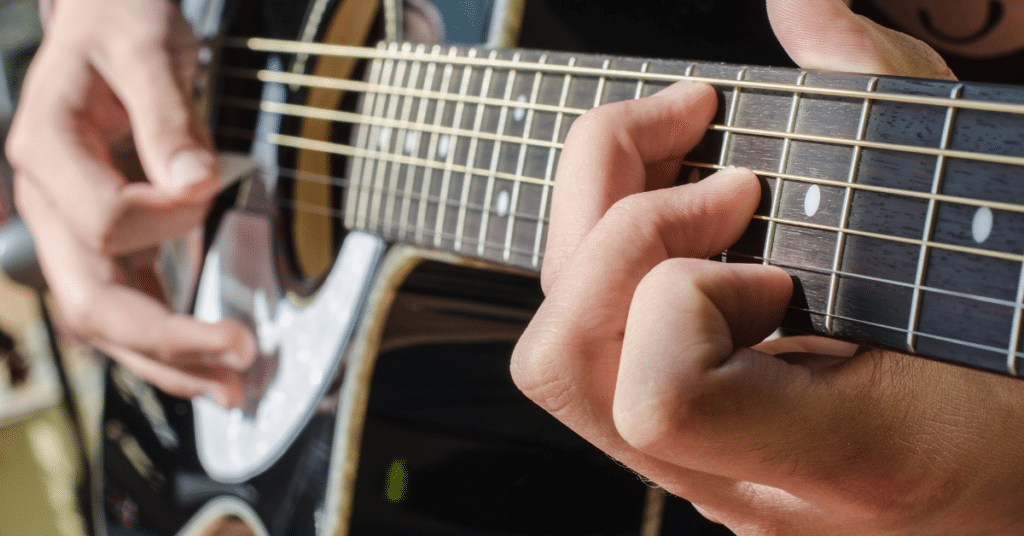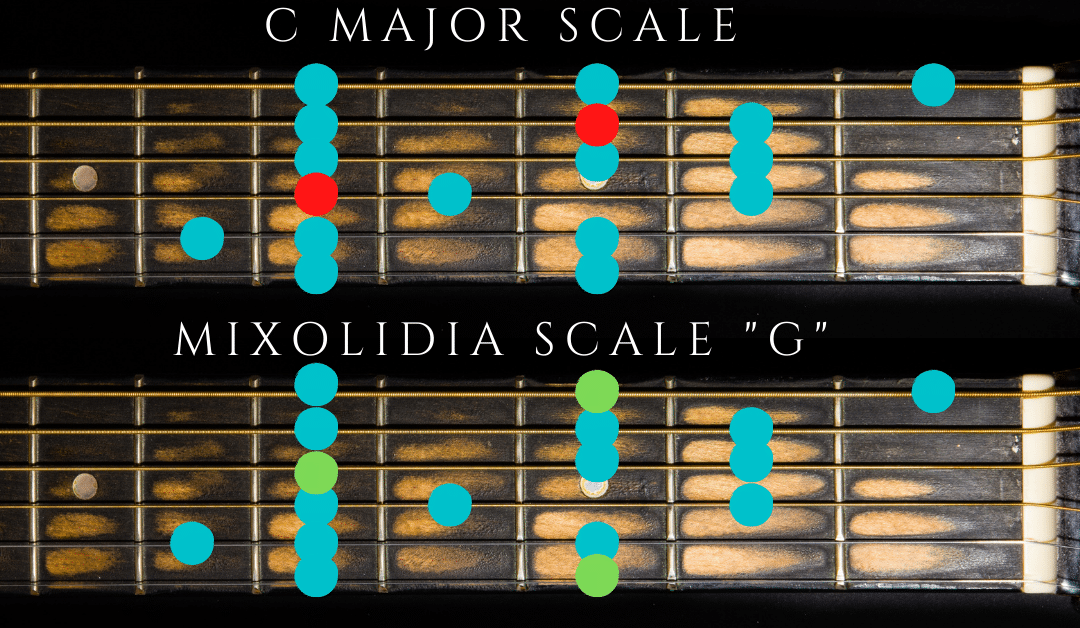Want to learn to play the mixolydian scale on guitar? Guns and Roses, the Beatles, and Madonna all have popular songs played with the mixolydian scale. Here is how you can play to!
Musical scales can be categorized in several ways based on the structure they adopt. While in some scales the third and fourth notes are separated by half a tone, in others it might be the fifth and sixth or other notes that are separated by half a tone. The mixolydian scale represents one of the many structures that we can find and, because of this, it is characterized by particular features that make its sonority a very useful tool to enrich compositions and improvisations.
What is the Mixolydian Scale on Guitar?
The Mixolydian Scale is commonly called the ‘Mixolydian mode’, it is the fifth of the seven currently established modal scales.
The denotation of ‘mode’ can refer to ‘the way of being’ that the scale possesses, its nature and its structure. The Mixolydian mode, or Mixolydian scale, is a guitar scale whose notes are separated by the following distances:
| Tone | Tone | Semitone | Tone | Tone | Semitone | Tone |
The Mixolydian scale is formed by playing a major scale but starting from the fifth note as the main note or tonic. This will result in a scale structured similarly to the major scale, except that its seventh note will be flattened. That is, we could take any major scale, play it from its fifth note and obtain as a result a new scale whose main note (tonic) will be the fifth note of the original scale used.
For example, let’s suppose we have the C major scale, whose notes are:
| Do | Re | My | Fa | Sol | The | Yes | Do |
If we play the scale starting from its fifth note, G, we obtain the G mixolydian scale, or G in mixolydian mode. That is:
| Sol | The | Yes | Do | Re | My | Fa | Sol |
Note that the G mixolydian scale has an F natural, while in the G major scale the note F is sustained. If you play both G major and mixolydian scales, you will notice a difference in the sound of the seventh note that could alter the whole behaviour of the scale. In this way, starting from the other major scales, we can find the mixolydian scale for the rest of the notes.
Two scales with the same notes?
An important aspect to take into account in the previous example (and later ones) is that the C major scale and the G mixolydian scale have the same notes. It can be confusing since they could be interpreted as one and the same scale. However, they should not be considered as two equal scales. Although they share the same notes, the use of each one will be different. To better understand this difference, you can compare the degree of each note in both scales.
| Grade | C Major Scale | G Mixolydian scale |
| I | Do | Sol |
| II | Re | The |
| III | My | Yes |
| IV | Fa | Do |
| V | Sol | Re |
| VI | The | My |
| VII | Yes | Fa |
Thus, in each scale the degrees correspond to different notes and, with this, the functionality of each one will vary.
Chords to Play the Mixolydian Scale on Guitar
It can be very easy to identify the patterns of the mixolydian scales on the guitar if you know the patterns of the major scales. We can identify the respective major scales and play over them in the mixolydian key. So, for example, see what the C major scale pattern would look like compared to the G mixolydian scale pattern.

Note that both scales are equal. The difference will reside in the use we make of the notes of these scales, taking into account that the main note is not the same, since in one it is C and in the other it is G . However, we could also play the mixolydian scale of any note starting from the major scales of the same note. For example, if we already know the G major scale pattern, to find its mixolydian mode we only have to identify the seventh note and lower it half a tone. Both methods are valid, and the use of one or the other may depend on the musician’s own skill in playing scales. However, the theoretical considerations remain no matter which path is taken.
Now, let’s look at some mixolydian scales and their construction from the major scales.
Mixolydian C scale
It can be constructed from the F major scale, the fifth note of which is C. Thus, when we play eight notes of the F major scale starting on its fifth (or dominant), we will obtain the following scale:
| Do | Re | My | Fa | Sol | The | Bb | Do |
The structure of the scale corresponds to the structure of the major scales, but its seventh note is flattened. Thus, the C mixolydian mode is obtained.
Mixolydian B scale
Following the same procedure, we must look for a major scale that has the note B as a fifth or dominant. With the help of study and practice it can be found that the E major scale fulfills this requirement. Then, by taking eight notes in this scale, starting from its fifth, you will obtain:
| Yes | C# | Re# | My | F# | G# | The | Yes |
It corresponds to the B major scale with the flatted seventh note. In this way, the mixedolydian scale of Si was arrived at.
Mixolydian scale of E
Now, instead of finding the mixolydian scale based on the major scale of another note, we can start from the major scale of the same note. Thus, to find the E mixolydian scale based on the E major scale, we only have to flatten its seventh note. That is, we have the original major scale:
| My | F# | G# | The | Yes | C# | Re# | My |
Then, by diminishing half a tone to the seventh note, we will be left with:
| My | F# | G# | The | Yes | C# | Re | My |
Then, following these examples, the Mixolydian mode can be constructed from the remaining notes. It is a good exercise for those musicians who need to practice their music theory since the procedure reinforces the knowledge of major scales, intervallic distances and the sonority of the modes in contrast to the original scale. In turn, to visualize each of these scales on the guitar, it will be enough to visualize the major scale patterns with their respective flatted sevenths.
Is the Mixolydian scale major or minor?
The Mixolydian scale is similar to the major scale or Ionian mode. Their structures are very similar and vary only in one note (the seventh). Unlike the minor scale, which has a distribution of notes and intervals that is more different from the distribution of the mixolydian scale.
We may commonly ask whether a scale is major or minor. But in the case of a mixolydian scale it is not so easy to answer such a question. Major and minor scales are, in fact, modal scales. The major scale corresponds to the Ionian mode and the minor scale to the Aeolian mode. So, when we say that a scale is major or minor, we mean that the scale has one structure or another. In the same way, when we say that a scale is mixolydian, we mean that it has another specific structure.
Harmonization of the Mixolydian scale
One of the most used tools that the mixolydian scale has for the interpretation of songs on the guitar (and on any harmonic instrument), are the chords obtained in its harmonization. To harmonize this scale it must be taken into account that the accidentals (sharps and flats) are not the same as the accidentals of the major or minor scale. Thus, knowing that the mixolydian scale has a similar structure to the major scale but with a flatted seventh, we can harmonize mixolydian scales as if they were major scales and diminish half a tone to their respective sevenths.
In general, the harmonization of the Mixolydian scale generates the following types of chords:
| Grade | Acorde de Triad | Chord with Seventh |
| I | more | dominant |
| II | minor | minor 7 |
| III | minor b5 | minor 7b5 |
| IV | more | greater 7 |
| V | minor | minor 7 |
| VI | minor | minor 7 |
| bVII | more | greater 7 |
Then, we have the chords formed with triads (three notes) and the chords with sevenths (four notes). To visualize it better we can take as an example the G mixolydian scale, harmonize it and represent it with the help of the American cipher:
- G: G major
- Am: A minor
- Bmb5: B minor with flatted fifth
- C: C major
- Dm: D minor
- Em: E minor
- F: F major
The same can be done with the rest of the mixolydian scales. At the same time, as practice, you can play these chords on the guitar one after the other and compare them with the chords of the major scale. On the other hand, it is important to note that the first chord, corresponding to the main note of the scale, forms a major chord. This will give the mixolydian key a sonority very similar to the major scale.
Mixolydian chord progressions
Once the musician becomes familiar with the chords of a mixolydian scale it is inevitable to want to use them and experiment with the sonority they evoke. It is very interesting to build the same chord progressions that could be applied to major scales and find different forms of musical expressiveness in both. However, it might not be so easy to play a mixolydian chord progression since, as we have already seen, they come from a scale that shares the same notes with some major scale. This could confuse the musician and force him to rest the progressions on chords of the major scale instead of the mixolydian scale.
(Want to learn more Harmonization, here is how you can harmonize the D Major chords)
For example, suppose we take the chords of the harmonized G mixolydian scale and write the following progression:
- G – Am – Dm – G – G – C – Am – F – G
All the chords indicated belong to the key of G mixolydian and, in turn, to the key of C major. This way, the progression could sound good both with the G major at the end and with an additional C major chord. In both cases there will still be chords belonging to both keys, but the key of the progression will tend to one or the other. It is imperative to take care of the chords on which to rest a progression in order to establish the tonality. In the same way, the final result will depend on the musician’s intention and the feeling he wants to transmit.
Examples of Mixolydian Chord Progressions
The following progressions are expressed in terms of the degree of the chords to be used and can be taken as a basis for further mixolydian chord combinations:
- I – IV – V – I
- I – II – IV – I – IV – IV – V – I
- I – VII – IV – V – V – IV – I
- I – V – I – VII – VII – IV – V – I

What does the Mixolydian mode sound like?
Since the mixolydian scale shares certain sonic features with the major and minor scales, a wide variety of aural expressions can be produced. Its first chord is major, so we can compose lively and cheerful progressions with the help of fast and moving rhythms.
On the other hand, unlike the major scales, the Mixolydian scale has a minor fifth degree and a third degree with the flatted fifth. These chords can help introduce new colors to the song, giving it a sadder and calmer expressiveness. In any case, the final result will depend on how the musician combines the idea of melody, harmony and rhythm.
Use of the Mixolydian scale
Nowadays there are countless popular bands that use the mixolydian scale for songwriting and improvisation. It is common to find this scale in jazz, blues and rock, and because of this variety the mixolydian scale has become so versatile. The following songs can be taken as a reference for the study of the Mixolydian mode:
- Hey Jude – The Beatles (only a part of the song)
- Sweet Child o’ Mine – Guns n roses
- Don’t Tell Me – Madonna (in D mixolydian)
- Tequila – The Champs (in F mixolydian)
Conclusion
The Mixolydian scale is similar to the major scale but with the flatted seventh note. It has a sonority similar to that of a major key and, with the help of its own harmonization, can be enriched to produce a variety of sounds. It is a very easy scale to learn on the guitar and provides many tools for composing and improvising in many keys.
Tips
- Identify the patterns of each mixolydian scale on the guitar based on the major scales.
- Build mixolydian chord progressions taking care that the resting chords do not lead the key to the major scales.
- Join chord progressions with melodic phrases taken from the respective mixolydian scale.
- Look for songs in mixolydian tonalities and try to improvise based on them.
Best of luck on your musical journey learning new scales. Take a look at a few of our other guides to learning popular scales:

